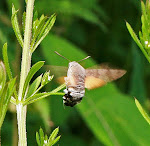The extremely hot sunny weather over these few days provided an opportunity to see some of the interesting butterflies which fly at this time of year. Whitbarrow (south Cumbria) and Gaitbarrows NNR (north Lancashire) are both excellent sites for butterflies as well as much else. At each, there are good colonies of the nationally-scarce Duke of Burgundy Fritillary whose habitat is woodland glades and open scrub with an abundance of its larval food plant, Cowslip (Primula veris). A rather small neatly-marked butterfly, it flies from mid-May into June.
.jpg)
.jpg)
.jpg)
Duke of Burgundy Fritillary
Also at these sites, the Pearl-bordered Fritillary can be found, another species under threat which has seriously declined in recent years. Again, woodland glades are favoured where there are violets (Viola spp.), its food plant. This butterfly is in flight a few weeks earlier than the commoner, less threatened, but closely-related Small Pearl-bordered Fritillary.
.jpg)
.jpg)
Pearl-bordered Fritillary: (the characteristic spotting on the underside of the wing distinguishes it from its relative, the Small Pearl-bordered Fritillary).
At Gaitbarrows on the barer, stony areas, the Dingy Skipper was active and very restless but rarely perched for long and so made photography difficult. Its food plant, Bird's foot Trefoil (Lotus corniculatus) didn't appear to hold its interest on this occasion.
.jpg)
Dingy Skipper
At Foulshaw (south Cumbria), Orange Tips and Speckled Woods were flying but a small colony of Green Hairstreaks which favoured a small patch of Garlick Mustard (Alliaria petiolata) was of particular interest. This is the only British butterfly with green-pigmented scales. Often found in scrub, it has a wide range of food plants.
.jpg)
.jpg)
Green Hairstreak
Nearby, a brightly coloured, newly emerged Small Copper was flying. Species of Rumex (Sorrel) are its foodplant.
.jpg)
Small Copper
.jpg)






No comments:
Post a Comment